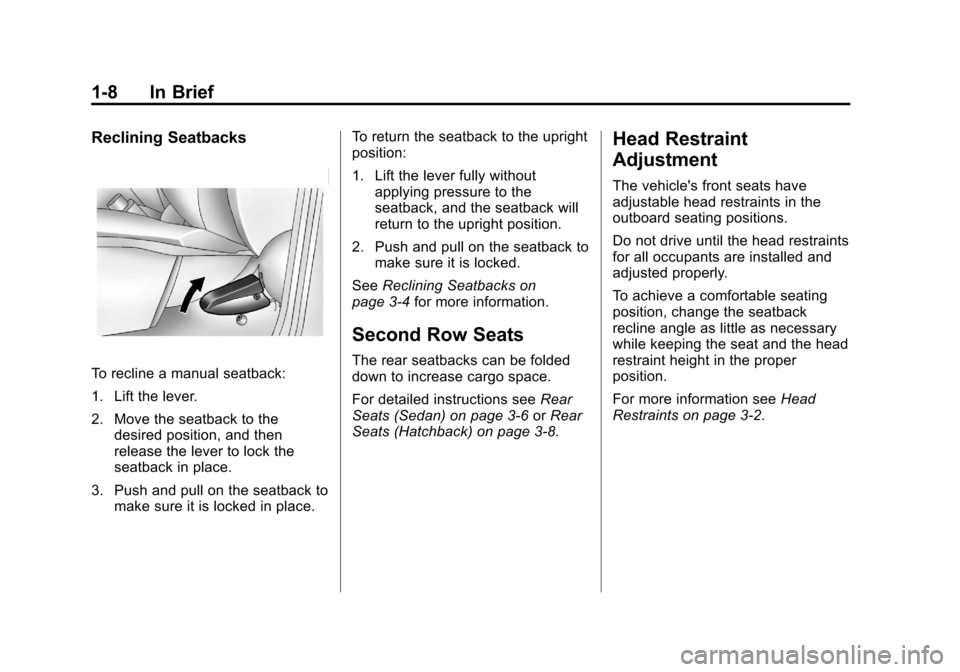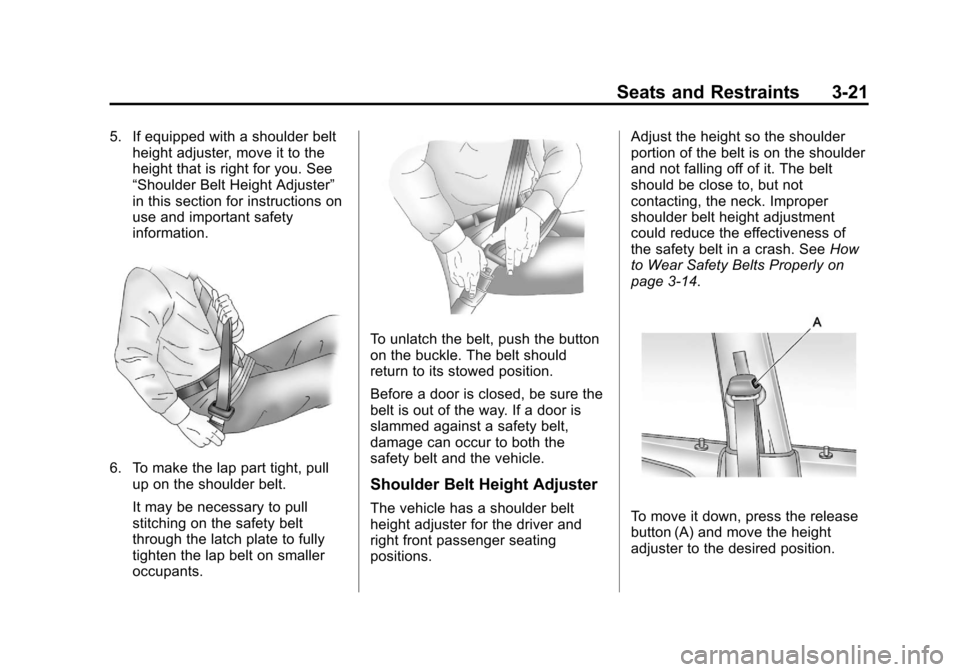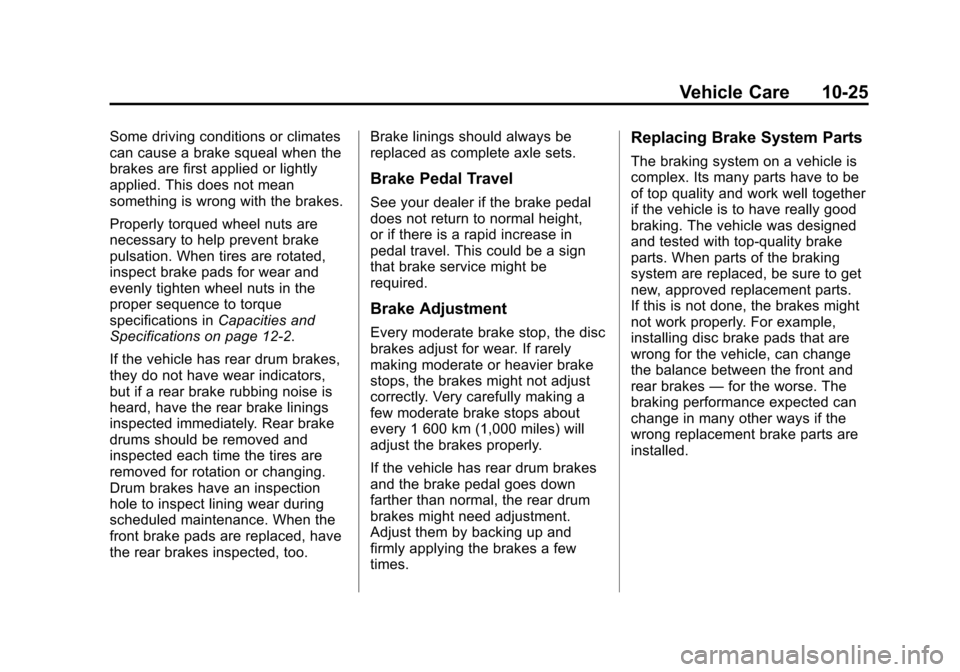Page 13 of 328
Black plate (7,1)Chevrolet Aveo Owner Manual - 2011
In Brief 1-7
Seat Adjustment
Manual Seats
To adjust a manual seat:
1. Lift the bar under the front of theseat to unlock it.
2. Slide the seat to the desired position and release the bar.
3. Try to move the seat back and forth to be sure it is locked in
place.
See Seat Adjustment on page 3‑3
for more information.
Seat Height Adjuster
Turn the knob on the outboard side
of the seat to adjust the height of
the driver seat cushion.
Turn the knob forward to raise and
rearward to lower.
See Seat Adjustment on page 3‑3
for more information.
Manual Lumbar
Move the adjustment lever on the
outboard side of the seatback up or
down to one of three positions to
increase or decrease the lumbar
support.
The highest position provides the
most support and the lowest
position provides the least support.
See Lumbar Adjustment on
page 3‑4 for more information.
Page 14 of 328

Black plate (8,1)Chevrolet Aveo Owner Manual - 2011
1-8 In Brief
Reclining Seatbacks
To recline a manual seatback:
1. Lift the lever.
2. Move the seatback to thedesired position, and then
release the lever to lock the
seatback in place.
3. Push and pull on the seatback to make sure it is locked in place. To return the seatback to the upright
position:
1. Lift the lever fully without
applying pressure to the
seatback, and the seatback will
return to the upright position.
2. Push and pull on the seatback to make sure it is locked.
See Reclining Seatbacks on
page 3‑4 for more information.
Second Row Seats
The rear seatbacks can be folded
down to increase cargo space.
For detailed instructions see Rear
Seats (Sedan) on page 3‑6 orRear
Seats (Hatchback) on page 3‑8.
Head Restraint
Adjustment
The vehicle's front seats have
adjustable head restraints in the
outboard seating positions.
Do not drive until the head restraints
for all occupants are installed and
adjusted properly.
To achieve a comfortable seating
position, change the seatback
recline angle as little as necessary
while keeping the seat and the head
restraint height in the proper
position.
For more information see Head
Restraints on page 3‑2.
Page 53 of 328
Black plate (3,1)Chevrolet Aveo Owner Manual - 2011
Seats and Restraints 3-3
Front Seats
Seat Adjustment
Manual Seats
{WARNING
You can lose control of the
vehicle if you try to adjust a
manual driver seat while the
vehicle is moving. The sudden
movement could startle and
confuse you, or make you push a
pedal when you do not want to.
Adjust the driver seat only when
the vehicle is not moving.
To adjust a manual seat:
1. Lift the bar under the front of theseat to unlock it.
2. Slide the seat to the desired position and release the bar.
3. Try to move the seat back and forth to be sure it is locked in
place.
Seat Height Adjuster
Turn the knob on the outboard side
of the seat to adjust the height of
the driver seat cushion.
Turn the knob forward to raise and
rearward to lower.
Page 71 of 328

Black plate (21,1)Chevrolet Aveo Owner Manual - 2011
Seats and Restraints 3-21
5. If equipped with a shoulder beltheight adjuster, move it to the
height that is right for you. See
“Shoulder Belt Height Adjuster”
in this section for instructions on
use and important safety
information.
6. To make the lap part tight, pull
up on the shoulder belt.
It may be necessary to pull
stitching on the safety belt
through the latch plate to fully
tighten the lap belt on smaller
occupants.
To unlatch the belt, push the button
on the buckle. The belt should
return to its stowed position.
Before a door is closed, be sure the
belt is out of the way. If a door is
slammed against a safety belt,
damage can occur to both the
safety belt and the vehicle.
Shoulder Belt Height Adjuster
The vehicle has a shoulder belt
height adjuster for the driver and
right front passenger seating
positions. Adjust the height so the shoulder
portion of the belt is on the shoulder
and not falling off of it. The belt
should be close to, but not
contacting, the neck. Improper
shoulder belt height adjustment
could reduce the effectiveness of
the safety belt in a crash. See
How
to Wear Safety Belts Properly on
page 3‑14.To move it down, press the release
button (A) and move the height
adjuster to the desired position.
Page 227 of 328

Black plate (25,1)Chevrolet Aveo Owner Manual - 2011
Vehicle Care 10-25
Some driving conditions or climates
can cause a brake squeal when the
brakes are first applied or lightly
applied. This does not mean
something is wrong with the brakes.
Properly torqued wheel nuts are
necessary to help prevent brake
pulsation. When tires are rotated,
inspect brake pads for wear and
evenly tighten wheel nuts in the
proper sequence to torque
specifications inCapacities and
Specifications on page 12‑2.
If the vehicle has rear drum brakes,
they do not have wear indicators,
but if a rear brake rubbing noise is
heard, have the rear brake linings
inspected immediately. Rear brake
drums should be removed and
inspected each time the tires are
removed for rotation or changing.
Drum brakes have an inspection
hole to inspect lining wear during
scheduled maintenance. When the
front brake pads are replaced, have
the rear brakes inspected, too. Brake linings should always be
replaced as complete axle sets.
Brake Pedal Travel
See your dealer if the brake pedal
does not return to normal height,
or if there is a rapid increase in
pedal travel. This could be a sign
that brake service might be
required.
Brake Adjustment
Every moderate brake stop, the disc
brakes adjust for wear. If rarely
making moderate or heavier brake
stops, the brakes might not adjust
correctly. Very carefully making a
few moderate brake stops about
every 1 600 km (1,000 miles) will
adjust the brakes properly.
If the vehicle has rear drum brakes
and the brake pedal goes down
farther than normal, the rear drum
brakes might need adjustment.
Adjust them by backing up and
firmly applying the brakes a few
times.
Replacing Brake System Parts
The braking system on a vehicle is
complex. Its many parts have to be
of top quality and work well together
if the vehicle is to have really good
braking. The vehicle was designed
and tested with top-quality brake
parts. When parts of the braking
system are replaced, be sure to get
new, approved replacement parts.
If this is not done, the brakes might
not work properly. For example,
installing disc brake pads that are
wrong for the vehicle, can change
the balance between the front and
rear brakes
—for the worse. The
braking performance expected can
change in many other ways if the
wrong replacement brake parts are
installed.